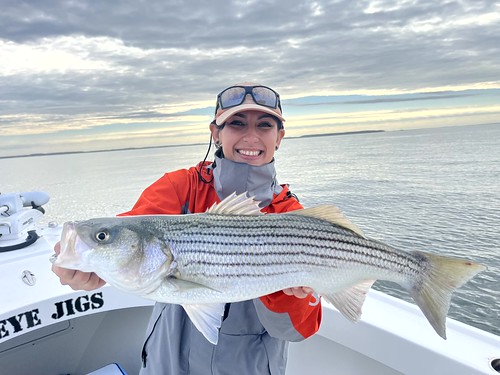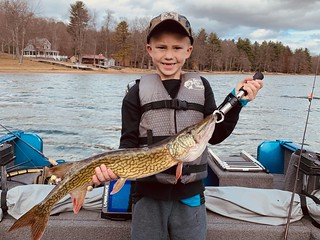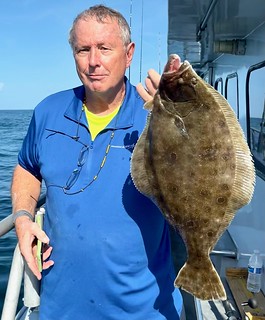Maryland Fishing Report – November 9

Kaelyn O’Hop has a good reason to smile as she holds up this great-looking striped bass she caught recently. Photo by Travis Long
Chilly nights and pleasant days are heralding late fall, and anglers are trading their lighter clothing for more substantial and warmer attire to enjoy the outdoors and the wonderful fishing opportunities of the season.
The University of Maryland Eastern Shore has designed a 15-minute online survey with a goal of reaching at least 1,400 anglers and fish enthusiasts in Maryland. Your input would be valuable to this research effort to better understand recreational fisheries in Maryland.
Forecast Summary: November 9 – November 15:
There will be a brief stretch of sunny, moderate weather prior to Friday, after which rain and a cold front will dominate the weather for the next week. On Friday we can expect winds of 15-20 knots with higher gusts, but the winds will drop down for the rest of the week. Chesapeake Bay surface water temperatures are holding in the 60s and should continue to drop this upcoming week. Maryland rivers are currently running in the low 50s.
As waters cool, resident and juvenile striped bass will continue to follow baitfish and move out of the rivers and into deeper, warmer waters of the main Bay such as channel edges, underwater points, hard bottom, and drop-offs. Using light and water temperatures as cues, resident fish will begin moving towards overwintering areas.
Expect average flows for most Maryland rivers and streams. There will be above average tidal currents through Sunday due to the November 8 full moon.
Expect average water clarity for most Maryland portions of the Bay and rivers. However, expect poor water clarity from algal blooms in the Back, Bush, and North East rivers. To see the latest water clarity conditions, check Eyes on the Bay Satellite Maps on the Maryland DNR website.
For more detailed and up-to-date fishing conditions in your area of the Bay, be sure to check out Eyes on the Bay’s Click Before You Cast.

Rob Trenary shot this huge 19.4-pound northern snakehead in the Elk River with a bow recently and it fell just short of the existing record of 19.9 pounds set by Andrew Fox in 2018. Photo courtesy of Rob Trenary
Striped bass fishing at the Conowingo Dam pool and the Susquehanna Flats continues to be slow this week, with a few fish being caught during the early morning hours. If you want some fishing action, there are plenty of large flathead catfish holding in the pool near the turbine tailrace. Blue catfish can be found in the lower Susquehanna River and surrounding tidal rivers in the region.
Cooler water temperatures are causing northern snakeheads to be sluggish, and with grass beds declining they can often be found in shallower waters, warming in the afternoon sun. Any shoreline submerged brush is a good place to look, and white paddletails or large minnows are good choices for bait.
Surface water temperatures climbed a little bit last week due to the unusually warm weather, but now water temperatures are back on a downward trend. The tidal rivers tend to be cooler than the Bay, and these lower temperatures are causing baitfish – juvenile menhaden, bay anchovies, and silversides – to exit the tidal rivers.
Striped bass are lining up at the mouths of the tidal rivers and channel edges in the Bay to feast on the bounty coming their way. Breaking fish can be spotted at times and provide plenty of fun casting, but most of the action is taking place below the surface. Jigging with soft plastic or metal jigs is the most popular way to fish. Striped bass can be found by watching depth finders. Resting flocks of seagulls and slicks are good signs there may be striped bass suspended below.
The mouth of the Patapsco, Magothy, and Chester rivers continue to be good places to fish for striped bass this week, and the Love Point Rocks should not be overlooked. The edges of the main channels in the Bay are good places to check for fish suspended in 25 feet of water or more. Jigging will be one of the more popular ways to fish, but trolling is another option. Single and tandem rigged bucktails can be trolled shallow, and umbrella rigs pulled behind heavy inline weights is a good way to reach where striped bass are holding deep along channel edges.
White perch are now holding in some of the deepest channels at the mouths of the tidal rivers and out in the Bay. Anglers who are targeting them are using bottom rigs baited with pieces of bloodworm or peeler crab. Yellow perch are being found in some deeper waters in the upper sections of their spawning rivers. Anglers are fishing them with small lip-hooked minnows and beetle-spin type lures worked close to the bottom.
The Bay Bridge and the sewer pipe continue to get the attention of anglers this week. There are certainly other places to fish for striped bass, but the bridge piers tend to be a first stop for boats coming out of the Sandy Point ramps. Jigging around those locations is a good choice, as is drifting with live eels and cut baits at the bridge piers. Trolling single or tandem rigged bucktails along the sewer pipe can also produce fish.
The stretch from the mouth of Eastern Bay across to Chesapeake Beach has been one of the striped bass hotspots for the past week. The fish are holding in about 25 feet of water along channel edges. Breaking fish are being spotted but heavy boat traffic puts them down quickly, so watching a depth finder is a key to locating suspended fish. Jigging is the most popular way to fish, but trolling can also be effective. Trolling bucktails in shallower areas without inline weights can work well, and of course heavy inline weights will get umbrella rigs down to depths of 20 feet or more where fish are holding.
The 30-foot outside edges at Hacketts Bar and Thomas Point are good places to find striped bass. The mouth of the Severn and Choptank rivers are excellent, and the False Channel is another hotspot. Bait in the form of juvenile menhaden and bay anchovies continue to move out of the tidal rivers into the Bay, and are being swept along steep channel edges by swift currents.
Fishing the shallower waters of the middle Bay during the morning or evening hours, or anytime on overcast days, is very good this week. The striped bass are moving freely in the shallows and only move off to deeper waters when the sun rises high in the sky. Casting poppers is an exciting and delightful way to fish for striped bass. Fly anglers can have a lot of fun casting skipping bugs with a floating fly line.
White perch have moved to the deeper waters at the mouths of the region’s tidal rivers and out into the Bay. One of the best places to fish for them is the channel areas off Matapeake. Bottom rigs baited with pieces of bloodworm is the most popular way to fish for them.

Gene Wright caught this fine-looking striped bass near the Point No Point Light. Photo by Eric Packard
Much of the striped bass fishing in the lower Bay has been focused on the lower Potomac River. Jigging to suspended striped bass near Cobbs Island down to the mouths of the St. Clements and Breton bays has been good. The shallower waters are also providing good fishing in this area and near the mouth of the St. Mary’s River during the morning and evening hours.
The lower Patuxent River out to Cedar Point is providing good striped bass fishing this week in both the shallower waters and the edges of the deeper channels. The shallows are providing good fishing for those casting poppers, jerkbaits, and paddletails during the morning and evening hours. Jigging along the channel edges when striped bass can be spotted on depth finders is also good.
Striped bass can also be found out in the Bay along channel edges, sometimes on top as breaking fish, and other times down deep and suspended close to the bottom. Jigging is the most popular way to fish, but trolling is also an effective way to catch striped bass this time of the year. Heavy inline weights will get umbrella rigs down deep to where fish are holding close to the bottom. Single or tandem rigged bucktails dressed with twistertails or sassy shads without any weight can be used for shallower waters.
Shallow-water fishing for striped bass is good this week in the Tangier and Pocomoke sounds. Casting poppers, Zara Spooks, and paddletails near marsh edges, stump fields, and points are providing a lot of fun action for light-tackle anglers during the morning and evening hours.
White perch have moved into the deeper waters of the channels at the mouths of the tidal rivers. They prefer hard-bottom areas such as oyster bars and can be found in waters as deep as 40 feet as the winter months approach. Structure such as deep-water bridge piers provide a draw for them in the Potomac and Patuxent rivers.
Recreational crabbing continues to be good if you are willing to go deep. The best reported catches are coming from waters 15 feet to 20 feet deep. The size of the crabs is nothing short of spectacular. Water temperatures are steadily declining, so the good crabbing is not going to last forever. The Gunpowder and Magothy rivers in the upper Bay and most areas south of Kent Island are providing good crabbing this week.

Asher Krampf caught this fine-looking chain pickerel in Deep Creek Lake recently. Photo courtesy of Asher Krampf
The fall trout stocking program has ended but there are still plenty of trout to be found in the put-and-take areas that were recently stocked. Many of those areas are ponds, and trout tend to be available for quite a while into November and December. In the streams and rivers, a fair number of the trout have spread out from where they were stocked. Casting small spinners, spoons and jerkbaits is a good way to cover water and entice them to strike. Fly anglers can use various nymphs, streamers, and a variety of wooly bugger type flies. Check the DNR trout stocking website to find the recently stocked locations.
In the western region of the state, fishing is very good at Deep Creek Lake and the upper Potomac River. Conditions at Deep Creek Lake are near ideal for smallmouth bass, yellow perch, crappie, largemouth bass, northern pike, and chain pickerel. Walleye fishing is improving. Fishing for smallmouth bass on the upper Potomac is good, as water conditions are low and clear.
Largemouth bass are active in ponds, reservoirs, and tidal rivers throughout the state as they feed aggressively. They can be found in transition waters between the shallows and the deeper drop-offs as they intercept baitfish and crayfish moving to deeper waters for the winter. Sunken wood is a magnet for largemouth bass in these transition areas and largemouth bass will hold close to any kind of structure they can find. Spinnerbaits, jerkbaits, and lipless crankbaits are good choices in the transition areas, while grubs and craw jigs are good choices for working deeper structure.
Cooler water usually translates into good fishing for chain pickerel in ponds, reservoirs, and tidal rivers. The upper Magothy and Severn rivers tend to provide some of the best chain pickerel fishing. Sunken wood is a magnet for these ambush predators.
Surf anglers are still catching kingfish and spot on pieces of bloodworm, while flounder are being caught on strips of spot or squid. Anglers fishing with large cut menhaden baits are catching a few striped bass and large red drum. Most of the striped bass fail to meet the 28-inch minimum and the red drum are also a catch-and-release fishery. Clear-nose skates are keeping anglers busy, and using the head of a menhaden helps limit the abuse the skates are giving bait.
At the inlet and Route 50 Bridge area, tautog and sheepshead are being caught near the jetty rocks and bridge piers on sand fleas. Flounder are being caught with live spot or minnows, fresh silversides, small menhaden, and Gulp baits. Striped bass are being caught on soft plastic jigs and bucktails.
A large portion of the flounder in the back bay waters have left but the channels near the inlet are the best place to catch stragglers headed to offshore waters. Striped bass are providing fun catch-and-release action, due to being undersized, at the Route 90 and Verrazano Bridge piers.
The inshore and offshore wreck and reef sites are providing excellent fish for sea bass this week, and boat catch limits are a common occurrence. Anglers are also catching a mix of flounder, triggerfish, and porgies. The boats headed to the canyons are focusing on deep-dropping for blueline tilefish and swordfish.
“Anglers have a way of romanticizing their battles with fish.” – Ernest Hemingway
Maryland Fishing Report is written and compiled by Keith Lockwood, fisheries biologist with the Maryland Department of Natural Resources.
Click Before You Cast is written by Tidewater Ecosystem Assessment Director Tom Parham.
This report is now available on your Amazon Echo device — just ask Alexa to “open Maryland Fishing Report.”


 1-888-373-7888
1-888-373-7888 233733
233733